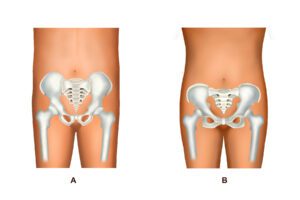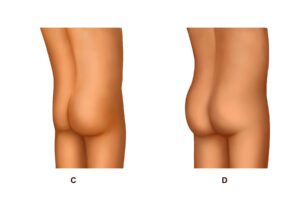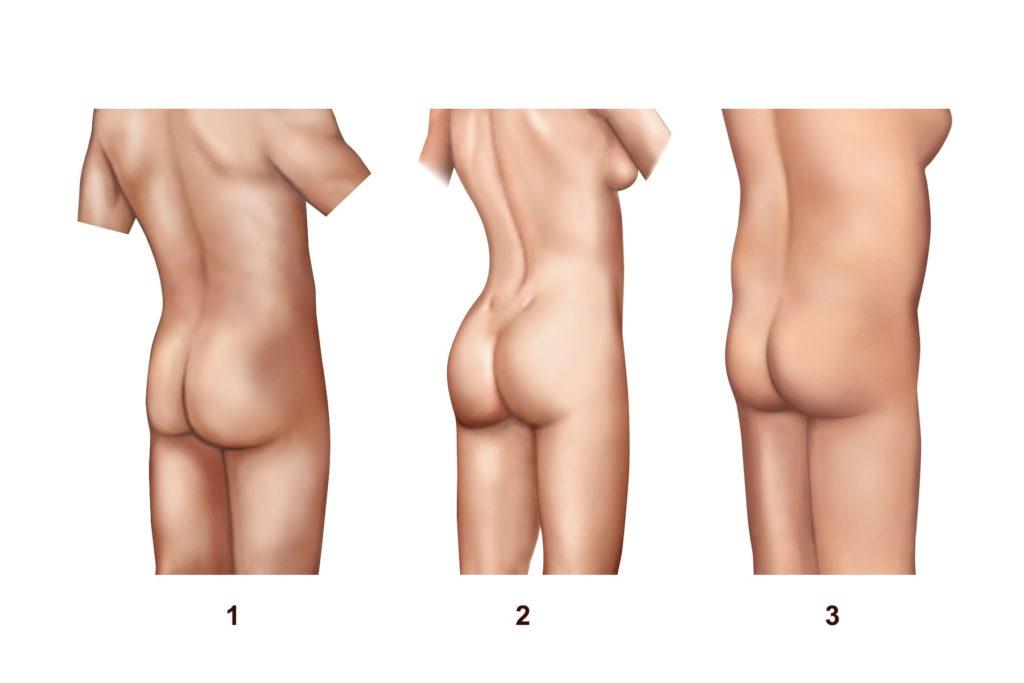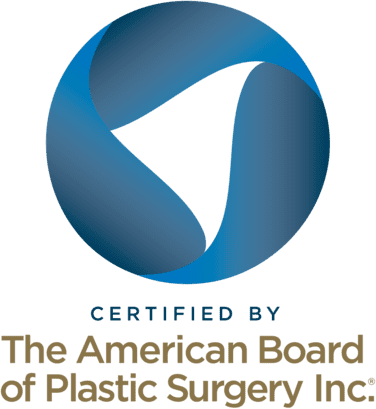Body Feminization Surgery: Options, Treatment Areas & Recovery
Medically reviewed by Jennifer Richman on June 12, 2025.
Body Feminization Surgery (BFS) Is:
Body feminization Surgery (BFS) is an umbrella term for liposuction, fat transfer, and skin excision procedures like an abdominoplasty or tummy tuck that patients can choose from to create a more feminine figure. When estrogen hormone therapy, diet, and exercise alone do not make sufficient changes to the silhouette, gender-affirming body contouring surgery may be necessary for trans women and transfeminine non-binary patients to treat their gender dysphoria.
The body sculpting procedures that can help with feminization include liposuction, hip augmentation surgery (or hip dip fat transfer), buttocks augmentation (or transgender BBL), abdominoplasty, arm lift (or brachioplasty), and more. Patients interested in liposuction can target the following areas: arms, thighs, abdomen, lower back, and flanks.
Although our surgeons don’t require anyone to be on hormone replacement therapy (HRT) for gender-focused body contouring or breast augmentation, being on estrogen for a year prior may have a positive effect on fat distribution and gluteal shape. In the text that follows, we go over the common differences in body forms produced by estrogen vs. testosterone-dominant puberties. Using these trends in development as reference points, we discuss how liposuction and fat-grafting can be used to help our patients experience gender euphoria.
In the following video, Dr. Facque (he/him) describes how body contouring procedures can be used to alter the shape of a patient’s body:
Are You A Good Candidate for Gender-Focused Body Contouring?
You would qualify for Body Feminization Surgery if:
- Patients must be legal adults (age 18+) to qualify for surgery
- We use the informed consent model to determine surgical eligibility
- Explain the qualifications/requirements for this procedure to fall under gender-affirming care and who an ideal candidate would be.
- Explain the importance of meeting these qualifications for proper surgery and recovery.
You might not be a good candidate for Body Feminization Surgery if:
- Ideal candidates for liposuction and fat grafting are those who have a BMI under 32 since patients with a higher BMI are likely to not yield noticeable results
- Your surgeon will go over your general health and medical history to determine your eligibility for certain procedures
- Although our surgeons don’t require anyone to be on hormone replacement therapy (HRT) for gender-focused body contouring or breast augmentation, being on full doses of feminizing HRT for a year prior may have a positive effect on fat distribution, gluteal shape, and hip form.
Insurance requirements for gender-affirming body contouring:
- If patients would like to get insurance coverage for their procedure, they will need to meet certain requirements. At the GCC, our insurance advocacy team has a 90% success rate in helping patients secure coverage for when they have coverage from an insurance provider that has gender-affirming health benefits. Requirements to qualify for insurance include:
- A support letter from a licensed mental health professional
- Being on HRT for a continuous 12 months before surgery, unless there is a medical contraindication to treatment
Surgical Goal Setting: What Can and Can’t be Done to Feminize the Figure
Feminizing body contouring is meant to help trans and non-binary patients experience gender euphoria around the shape of their body, especially when hormone therapy and lifestyle changes to diet and exercise do not make sufficient changes for the patient’s gender embodiment goals.
We share the following information with our patients to help them prepare for a free virtual consultation where you can create a body feminization surgical plan tailored to your unique needs and goals:
Understanding the Effects of an Androgenic Puberty
Sometimes, trans women, nonbinary and gender diverse trans folks who underwent an androgenic (testosterone-dominant) puberty may experience discomfort or gender dysphoria or incongruence related to their body fat distribution. It is possible to reduce these feelings of dysphoria or incongruence through a variety of surgical and lifestyle choices. However, there are limitations to these changes, which we cover below.
The pubertal development someone undergoes in adolescence generally determines the bone structure they will have as an adult. Alterations in the bony framework are unlikely with hormone therapy, and surgical modification of the pelvis comes with significant risks that outweigh the benefits, based on current surgical techniques.
A full, first androgenic development tends to have the following effects on the body’s form:
- Increased subcutaneous fat deposition along the abdomen and flanks
- Narrow pelvic brims (see figure A below)
- Lower body fat than estrogenic forms
- The common waist-to-hip ratio (WHR) is in the range of 0.85 to 0.95
(Differences in fat deposition lead to varying degrees of WHR)
- Gluteal form has a ‘flatness’ or concavity (see figure C below)
A full, first estrogenic development tends to have the following effects on the body’s form:
- A greater proportion of fat is deposited in the gluteal areas and hips
- Wider pelvic brims (see figure B above)
- Approximately 10% more body fat compared to androgenic forms
- Common waist-to-hip ratio (WHR) in the ratio of 0.65 to 0.80 (The WHR varies due to differences in fat deposition)
- Gluteal form has a ‘fuller’ round shape (See figure D above)
Different Body Types
Each body is unique, and here are four examples of conventionally “feminine” body types. Your body frame will play a role in the type of results you can expect to achieve, so we recommend scheduling a free consultation with our surgical team to talk more about your unique goals.
Pear-Shaped
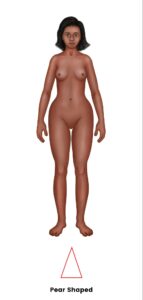
Pear-shaped bodies describe folks who have a hip measurement that is greater than their bust. While fat distribution varies, pear-shaped people are more likely to carry weight in the hips, buttocks, and thighs than in the upper body.
Banana

Banana-shaped bodies often possess a very even distribution of fat among their waist, buttocks, chest, and face, and have a banana or rectangular shape.
Apple-Shaped
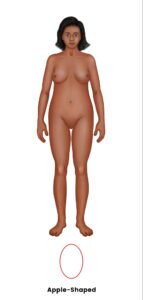
Apple-shaped bodies often have shoulders that are comparably broader than their hips. They can possess larger busts, a less defined waist, and thin hips and thighs. Fat is mainly distributed in the face, chest, and abdomen.
Hourglass
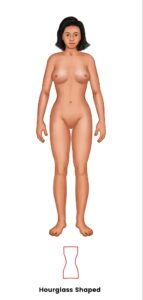
An hourglass shape describes a body type with fat that is distributed equally between the upper and lower body, paired with a very narrow waist.
Which Procedures will Help Me Reach My Body Feminization Goals?
Achieving a Lower Waist-to-Hip Ratio Through Feminizing Liposuction
Waist-to-hip ratio is found by dividing your waist measurement by your hip measurement. In general, folks assigned female at birth (AFAB) have a lower waist-to-hip ratio than people assigned male at birth (AMAB). Some patients seek a lower WHR to reduce feelings of gender dysphoria.
The first area we generally target for patients seeking a conventionally “feminizing” effect through body contouring is the trunk or lower torso. Though the actual number varies, we generally aim for a WHR of 0.7 when performing body contouring through trunk liposuction, common for patients seeking to “feminize” their body shape.
Lowering the waistline through trunk liposuction in the abdominal and flank regions can have a significant impact on the fit of clothing generally made for women, which tends to accentuate the waist.
Buttocks enhancement (BBL) and Hip Augmentation
The buttocks and hip region is the second area we generally target for patients seeking a conventionally “feminizing” effect through gender-affirming body contouring. Your surgeon can permanently augment these areas through a BBL fat transfer, hip dip fat transfer, or hip implants.
As you can see in the figures below, gluteal forms differ in all people. What may be viewed as a conventionally “masculine” gluteal form tends to have a flatness or concavity at the mid-lateral buttock, and a relative absence of lateral hip fullness.
A smooth inward sweep of the waist and lower back alongside wider hips is characteristic of a conventionally more “feminine” form. Therefore, approaches in body contouring for trans women and transfeminine nonbinary people aim at increasing the fatty tissue in the gluteal and/or hip regions to highlight a distinct transition from the lower back and widen the appearance of the hips.
Breast Augmentation
Alongside body feminization surgery, many patients choose to undergo a simultaneous gender-affirming breast augmentation surgery. Given the limited effects that estrogen HRT has on developing breast tissue in adults, many trans and non-binary patients opt for breast implants or fat transfer to augment the volume of the breasts.
Frequently Asked Questions about Feminizing Body Contouring
How long does body feminization surgery take?
Depending on the number of procedures you undergo, BFS can take 1.5-6 hours. Patients will be under general anesthesia for the duration of surgery, meaning they will be unconscious and will not feel anything.
What is the best way to feminize your body?
Every body feminization surgery is uniquely tailored to the gender embodiment goals and anatomy of each individual patient. Patients often elect for surgical procedures like liposuction, fat grafting, and skin excision because their results are permanent, leading to an effective and long-term feminization of the body’s shape.
Will Insurance cover body feminization surgery costs?
Some insurance plans that cover gender-affirming surgery may offer coverage for body feminization surgery when patients provide the proper support documentation.
If you have insurance coverage and we are a contracted provider, we are unable to offer you an out-of-pocket price for your medically necessary body contouring (liposuction and/or fat grafting procedure). This is due to the service being reimbursed at a drastically reduced amount, limiting our ability to provide this service at a reasonable reimbursable rate.
In the past, GCC billed for multiple units, each representing different areas on the body, and the procedure was reimbursed based on the number of units. However, insurance companies are now reimbursing for only one (1) unit, regardless of the number billed.
Please note that managed Medi-Cal plans, such as San Francisco Health Plan (SFHP), coverage has not changed for Liposuction, ensuring flexibility in Liposuction units.
For information about prices and financing options, we invite you to consult this page.
Is body feminization permanent?
Yes, unlike temporary fillers, the results of liposuction, fat grafting, and skin excision surgery are permanent. However, significant fluctuations in overall body weight will change and potentially diminish surgical results.
Recovery Timeline for Body Feminization Procedures
You can expect the following as you recover from body feminization surgery:
- Inflammation, bruising, and moderate pain will last about 3 weeks
- Patients whose jobs do not require heavy lifting can return to work after 2 weeks
- Compression garments must be worn at all times (except when showering) for 3 weeks to 3 months, depending on your surgeon’s indication
- If you undergo a fat grafting procedure, you will receive instructions to adjust sitting and lying down for the first 3 weeks to avoid tissue necrosis
- No heavy lifting or vigorous exercise until 6 weeks post-op.
- Patients who undergo skin excision procedures will receive instructions for incision and scar care
Breast Augmentation:
Initial/Short-Term Recovery: Most patients see a reduction in swelling and discomfort within 3 weeks, with daily activities being able to be resumed in 4-6 weeks.
Long-term Recovery: At ten weeks or more, you will enter the long-term recovery stage, with most visible scaring and swelling greatly reduced by the 3rd month.
Facial Feminization Surgery (FFS):
Since FFS involves various procedures, including rhinoplasty, jaw contouring, and brow reduction, recovery times may vary*
Initial/Short-Term Recovery: Improvement in swelling and bruising (which is common) is typically seen within 2 to 3 weeks; the resolution and settling of features can take 3 to 6 months.
Long-term Recovery: It can take up to a year or more for the final results of facial bone contouring and rhinoplasty to become fully apparent.
Chondrolaryngoplasty (Tracheal Shave):
Initial/Short-Term Recovery: This outpatient procedure has an initial recovery period of about 1 to 2 weeks.
Long-term Recovery: Full recovery and reduction of residual swelling can take up to 4 to 6 weeks.
Body Contouring:
Liposuction and fat grafting procedures may be able to be performed on an outpatient basis, but consult with your surgical team first*
Initial/Short-Term Recovery: Depending on the depth of the procedures and removal, it can take 2-4 weeks for initial recovery.
Long-term Recovery: Within 8-10 weeks, you should be able to resume your light/normal daily activities.
Vaginoplasty:
Initial/Short-Term Recovery: Patients are usually required to stay in the hospital for 3 to 7 days post-surgery. Then the first 4 to 8 weeks are focused on healing, with patients being advised not to do ANY strenuous activities or heavy lifting.
Long-term Recovery: It can take up to 8 to 12 weeks to return to light/normal levels of activity, with full healing taking up to a year or more.
For more detailed information, click here. Please note that your surgeon’s office will give you unique recovery instructions based on the number and type of procedures you undergo for your feminizing body contouring surgery.
In Summary..
In the following video, Dr. Facque (he/him) explains how body contouring can be used to reverse the effects of a first, testosterone-dominant puberty on the body’s shape.
Request a Free Surgical Consultation Today.
All virtual and in-person consultations with our board-certified surgeons are free. Once you fill out this form, our patient care team will reach out and guide you through every step to get to surgery.


